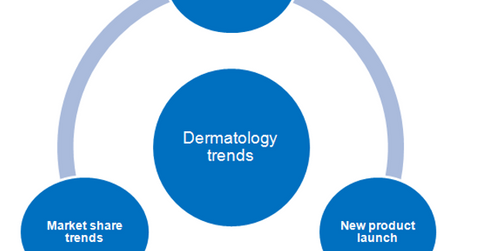Why Zoetis’s Apoquel and Cytopoint Are Expected to Report Robust Revenues
In 1Q17, Zoetis’s (ZTS) dermatology portfolio reported revenues of ~$57 million, driven by the steady adoption of Cytopoint and Apoquel.
May 17 2017, Updated 10:37 a.m. ET

US dermatology performance
In 1Q17, Zoetis’s (ZTS) dermatology portfolio reported revenues of ~$57 million, driven by the steady adoption of Cytopoint and Apoquel. The company expects to witness seasonality in its dermatology revenues in 2017 and projects higher revenues for 2Q17 and 3Q17, as compared to what it saw in 1Q17 and 4Q17.
Zoetis anticipates the acceleration of dermatology sales in 2Q17 due to the increased awareness caused by marketing campaigns and DTC (direct-to-consumer) advertising.
Strong demand in both the US and international markets is expected to boost Zoetis’ annual dermatology product sales around the world in the range of $400 million–$500 million by 2020.
Revenue growth trends in 1Q17
In 1Q17, Zoetis’s dermatology segment revenues rose 66% on a YoY (year-over-year) basis. Apoquel was the key driver in this segment and accounted for 47% of its YoY revenue growth.
Calendar 1Q17 was the first full quarter of availability for Cytopoint after receiving approval from the USDA (US Department of Agriculture). With Apoquel and Cytopoint, Zoetis is well positioned to compete with canine dermatology peers Merck (MRK), Eli Lilly (LLY), and Sanofi (SNY).
Market share trends
Apoquel is now being prescribed by 94% of the total veterinary clinics in the US. However, the drug accounts for only 47% of the patient market share, which suggests a significant upside potential for the drug. Apoquel aims to capture 30% of the dermatology market share currently held by steroid therapies.
Notably, Zoetis makes up about 0.12% of the Vanguard Total Stock Market ETF’s (VTI) total portfolio holdings.
New product launch
Zoetis’s newly launched dermatology product, Cytopoint, currently accounts for only 5% of the market share in the US. However, the drug is expected to witness the rapid penetration in clinics and an increase in patient share in 2017.
Continue to the next part for a discussion of Zoetis’s efforts to strengthen its product portfolio.
